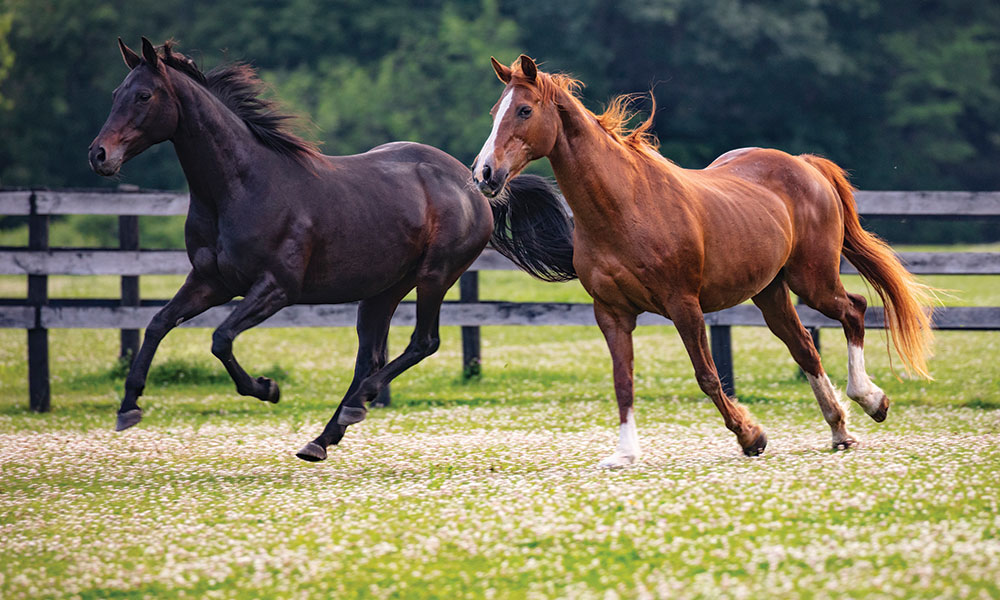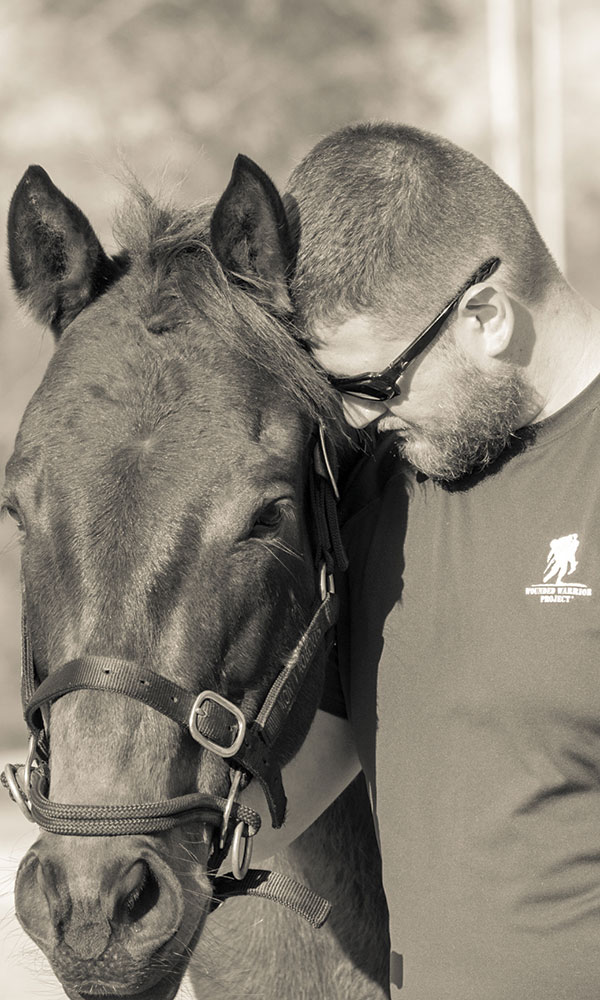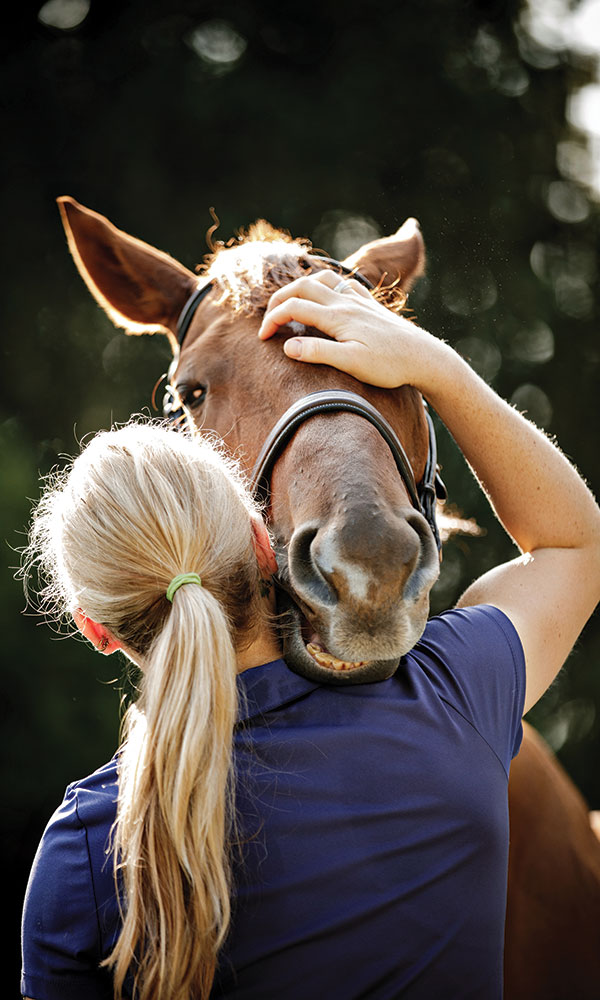In the beginning, Saratoga Springs owed its status as a luxury vacation destination to the mineral-rich waters flowing beneath its surface. Now, more than a century later, though the spas still hold their magical appeal, we truly owe it all to the horses. Without the Thoroughbreds that live, train and compete at Saratoga Race Course each summer, our city would have become a forgotten gem from an earlier era. To give back to the horses that have given so much to our city, many organizations in Saratoga and beyond are working to provide happy lives for Thoroughbreds and other horses after they retire. Here are three nonprofits that are proving a horse’s last lap isn’t the end of the line. It’s the beginning of a new, exciting chapter.

EQUINE ADVOCATES
This winter, Susan Wagner heard from a neighbor about a nine-year-old donkey that had been locked in a stall for almost his entire life. His owner, unfathomably, had 60 acres of land. Why he had a donkey in the first place, if he was going to keep him locked away, was a mystery to Wagner. She started trying to get the donkey away from the owner, and when she succeeded, sent him to Cornell University College of Veterinary Medicine for two weeks to be gelded and treated for various stages of neglect. When he was released, he went straight to Equine Advocates Rescue & Sanctuary, a 140-acre facility in Columbia County, NY, owned and operated by Wagner. “He had no clue about anything,” Wagner said about the donkey’s arrival. “I call him the boy in the bubble—he doesn’t even know how to walk. These are the kinds of animals that we take in.”
Just talking to Wagner, I can tell Equine Advocates, the foundation she started in 1996, and her sanctuary, which opened in 2004, are her life. With 83 equines—horses, ponies, donkeys and mules—in her care, it has to be. Wagner started Equine Advocates after she rescued her first horse, Gandalf, from slaughter. Since then, she’s rescued thousands of equines, and now brings her rescues to live out the rest of their lives in the sanctuary. Most of the equines Wagner rescues are, like Gandalf, headed to slaughter; they’re either already in a kill pen, or about to go to auction, where they’ll likely be purchased by kill buyers—middlemen looking to sell the animal to a slaughter plant. Others come directly from racetracks because of on-track injuries, or, like the donkey she rescued this winter, from situations of neglect.
Horses go to auction because they can no longer do the work they were raised or trained to do, whether that was racing, working on a farm or pulling buggies. “Just because a horse goes from being a racehorse to a show horse doesn’t ensure that they won’t end up falling through the cracks once they can’t be a show horse anymore,” Wagner says. “Let’s face it: Everybody gets old.” But that’s where Equine Advocates comes in—a horse’s age and abilities don’t matter at the sanctuary. “Last year, a Thoroughbred named Rose came here,” Wagner says. “She’s only 11 years old. For racing, that’s old, but for us, that’s pretty young.”
Each year, Equine Advocates hosts an annual gala to raise funds for the organization and to honor individuals doing admirable work to benefit equines. One of last year’s honorees was legendary New York City socialite, humanitarian, actress and saratoga living contributing editor, Cornelia Guest, who was honored for her work to bring an end to horse slaughter. “Susan Wagner has such incredible knowledge,” Guest tells me. “I think to have someone with such an incredible understanding fighting for horses is fantastic. She walks the walk and talks the talk. Most people are simply not like that.” I agree—she’s the real deal.

SARATOGA WARHORSE
In college, I did my senior thesis on childhood trauma—specifically on children placed in out-of-home care. I was interested in how early childhood events (like being removed from one’s parents) could manifest in such a defining way, even in adulthood. Throughout my research, I came across many organizations, family service professionals and counselors working to help children who had what are called Adverse Childhood Experiences (ACEs), and though these organizations were certainly making a difference, it’s often not enough. However, I’d never heard of any trauma programs involving horses. Until now.
Saratoga WarHorse is a three-day experience for war veterans who are struggling to adjust to life after military service. The program, started in Saratoga by Bob Nevins, a veteran himself, is an interactive experience between off-the-track Thoroughbreds and veterans. “I don’t do therapy,” Nevins says. “And I’m very clear with the veterans that we don’t do therapy; we don’t do touchy-feely.” Instead, Nevins teaches veterans how to “transcend the language barrier” with the horses, which are, by nature, flight animals. When the horse realizes the veteran knows its language, it asks for protection. “It asks you: ‘Can I bond with you? Will you become my new herd leader? Can I trust you?’” he says.
Nevins explains trauma like this: When a normal human being is exposed to a traumatic event, it’s like an emotional circuit breaker pops in order to protect them and get them through the crisis. But if the circuit breaker doesn’t reset, the person starts developing symptoms associated with post-traumatic stress, because they’re still in survival mode. And while that’s a good place to be in life-or-death situations, such as the ones a soldier might experience on the battlefield, it’s not good for everyday life. When a horse gives the person permission to “join its herd,” it triggers a re-regulation of the autonomic nervous system. “Neuroscientists are telling us what we’re doing is exactly what needs to happen in order to reset,” Nevins says. “But we know we can’t do this without the horse, because the horse is so unconditionally accepting.”
This year, Saratoga WarHorse is set to graduate its 1000th veteran since the program was founded in 2011. Jen Ormiston, a veteran from Ballston Spa who was deployed in Iraq in 2004, completed the program this March, and says it has given her her life back. “When I left the military, everything just kind of exploded,” she says. “I wasn’t sleeping well, I wasn’t eating. [I was having] nightmares and flashbacks, and was drinking—[doing] anything to avoid what I was feeling.” Ormiston tried traditional counseling, but it didn’t work for her. Saratoga WarHorse, she says, was a last-ditch effort. “I didn’t believe this was going to work for me. I was going to try this guy’s snake oil, and if it didn’t work, I was checking out. I was done.” It turns out, the program was exactly what she needed. “I can say for certain that nothing has helped in the way WarHorse did,” says Ormiston. “I can’t explain why or what happened. It’s truly like a switch was turned off. I just have this peace about me that I haven’t felt in a long, long time. And I really don’t think I would be around anymore if it hadn’t worked.”
It’s because of veterans like Ormiston that Nevins started Saratoga WarHorse. “It’s a national shame that more veterans die by suicide than in combat,” Nevins says. “We’d all do it again if we had to, as veterans, but man, I’m not a throwaway after I get hurt. These horses are not throwaways after they’re no longer able to compete at the highest level. There’s plenty of work for them to do.”
Thinking back to my senior thesis, I can’t help but wonder if Nevins’ methodology could be applied to victims of childhood trauma. “Absolutely,” he says when I ask him. “That’s what I’m trying to do: I’m trying to elevate this to a scientifically validated procedure that could benefit thousands of children, thousands of sexual assault victims. But I’m perfecting it here. And once it’s perfected, it can be duplicated.” For the sake of the hundreds of thousands of children who are born into situations that expose them to traumatic events, I can’t wait for that day to come.
Note: Shortly after this story was published, saratoga living learned that Bob Nevins, Founder and Director of the Veteran Program at Saratoga WarHorse, was no longer with the organization. While representatives within the organization didn’t immediately respond to a request for comment on Nevins’ departure, they did send out a press release on July 31, announcing the appointment of Army veteran Allison Cherkosly, Ph.D. as the organization’s new Executive Director.

NEW VOCATIONS
When I interviewed Saratoga Springs-based photographer Tracey Buyce for “The Saratoga 20” feature in saratoga living’s 20th Anniversary Issue, I remember two of her most memorable answers: She can make the best horse noises, and she takes “glamour shots” of retired racehorses to help them get adopted. While I was certainly impressed by her whinny, I was more interested in her work with New Vocations, a racehorse adoption program in Ballston Spa.
New Vocations, which has its national headquarters in Lexington, takes in retired Thoroughbreds and Standardbreds and trains them to be something other than racehorses. The number one discipline the horses are retrained for is pleasure trail-riding, followed by eventing, hunting and dressage. “We call it transitional training, because it really is like getting a completely new job,” says Leandra Cooper, the Thoroughbred Trainer at New Vocations’ Ballston Spa facility. “The horses are generally really young when they come in, so they need a little bit of help to adjust to the new lifestyle.” While racehorses can live to be between 25 and 30, they usually retire—and come to New Vocations—at only a few years of age.
The Ballston Spa location is a one-woman show put on by Cooper. She does all the training, managing and paperwork required, from accepting “donations” (i.e., racehorses) to getting the horses adopted. Typically, she has between 10 and 15 horses at a time, which usually stay at New Vocations for 40-60 days. “I have this short, intimate time with the horses,” she says. “But I’m never sad when they go. I’ll miss them, and I care deeply about every single horse, but I’m usually really excited to see what they’re going to do, because I know that I’ve given them these tools to be successful in another job.”
Besides the Lexington and Ballston Spa locations, New Vocations has an outpost in Pennsylvania and three in Ohio. Last year, the organization had a total of 1000 adoption applications come in. Of those 1000, 400 horses were adopted out. “The reason why we didn’t adopt out 1000 is because there’s a lot more interest in the horses that aren’t limited in what they can do, and the majority of the horses we’re getting have some type of limitation,” says Anna Ford, New Vocations’ Thoroughbred Program Director. That limitation, she says, is usually a physical injury sustained during the horse’s racing career.
These racing-related injuries (and fatalities) have obviously been a topic of much controversy in recent years at Saratoga. For this reason, organizations like New Vocations are imperative to the racing industry, Ford says. “New Vocations helps draw more fans to the industry,” she says. “One of the biggest concerns of people outside of the racing industry is what happens to the horses. So the more we can spread the word that there are programs out there like New Vocations, the better.” She’s right. As someone not directly involved with the racing industry, it warms my heart to know that we’re taking care of the horses that make Saratoga what it is, right here in our own backyard.


